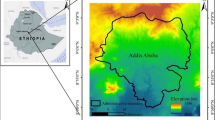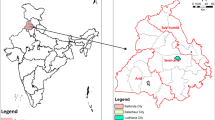Abstract
Examining the spatial variation of surface temperature is an important criterion to create livable urban environment. To examine the cause of heat island variation in the study area located within the rift zones, an algorithm that was prepared for Landsat 8 band 10 were used by taking the Normalized Difference Vegetation Index threshold method for the estimation of ground emissivity by integrating with the result obtained from MODIS night time data. The LU/LC (land use land cover) maps of the area were prepared with better accuracy using on screen classification technique. The derived LST showed that the surface temperature of the city ranges from 20.6 to 41.30 °C and the minimum temperature of the area was observed within the lake and the surrounding areas such as wetland. The maximum temperature was registered on the scattered hills and excavation areas and some parts of bare lands including industrial park of the city. The spatial variation of LST (Land Surface Temperature) in the city is the result of three major factors namely: (1) volcanic products of the geological setting, (2) the nature of the rock (high reflectance) and (3) the LU/LC type. Increasing of evergreen tree cover and rehabilitation of existing mining areas are among the recommended strategy to mitigate the UHI (urban heat island) effects in the city. For future studies in areas that are susceptible to natural heat sources, the satellite data should have high spatial resolution and derived from multiple sensors and satellites that can provide better tools to understand the UHI effect considering the geological setting of the area.














Similar content being viewed by others
References
Abutaleb, K., Adeline, N., Ahmed, F., Ahmed, M. H., Elkafrawys, S. B., Arafat, S. M., & Darwish, A. (2014). Investigation of urban heat island using Landsat data. In Proceedings of the 10th international conference on AARSE, University of Johannesburg, Wits University South Africa and National Authority for Remote Sensing and Space Sciences, Egypt (p. 9).
Adeyeri, O. E., Akinsanola, A. A., & Ishola, K. A. (2017). Investigating surface urban heat island characteristics over Abuja, Nigeria: Relationship between land surface temperature and multiple vegetation indices. Remote Sensing Applications: Society and Environment, 7, 57–68.
Avdan, U., & Jovanovska, G. (2016). Algorithm for automated mapping of land surface temperature using Landsat 8 satellite data. Journal of Sensors. 2016:1–8, Article ID 1480307. http://dx.doi.org/10.1155/2016/1480307.
Babalola, O. S., & Akinsanola, A. A. (2016). Change detection in land surface temperature and land use land cover over lagos metropolis, Nigeria. Journal of Remote Sensing & GIS, 5(2), 171. https://doi.org/10.4172/2469-4134.1000171.
Becker, F., & Li, Z. L. (1990). Towards a local split window method over land surfaces. International Journal of Remote Sensing, 11, 369–393.
Buongiorno, M. F., David, P., & Malvina, S. (2013). Thermal analysis of volcanoes based on 10 years of ASTER data on Mt. Etna. Remote Sensing and Digital Image Processing, 17, 409–428.
Burgan, R. E., & Hartford, R. A. (1993). Monitoring vegetation greenness with satellite data. Gen. Tech. Rep. INT-297. Ogden, UT: U.S. Department of Agriculture, Forest Service, Intermountain Research Station, p. 13.
Coffyn, B. M. (2011). Urbanization and land surface temperature in Pinellas County, Florida. Unpublished MA thesis, University of South Florida, USA, p. 155.
CSA. (2013). Population projection of Ethiopia for all regions at Wereda Level from 2014–2017 (population projection). Addis Ababa: Federal Democratic Republic of Ethiopia Central Statistical Agency.
Czajkowski, K. P., Goward, S. N., Stadler, J. S., & Walz, A. (2000). Thermal remote sensing of near surface environmental variables: application over the Oklahoma Mesonet. The Professional Geographer, 52, 345–357.
Darge, Y. M., Hailu, B. T., Muluneh, A. A., & Kidane, T. (2017). Detection of geothermal anomalies using Landsat 8 TIRS data in Tulu Moye geothermal prospect, Main Ethiopian Rift. In The 4th National GIS Summit, 13–15 January 2017, The Geospatial Data and Technology Centre (GDTC) of Bahir Dar University Bahirdar, Ethiopia.
Dewan, A., & Corner, R. (2012). The impact of land use and land cover changes on land surface temperature in a rapidly urbanizing megacity. In Proceedings of the IEEE international geoscience and remote sensing symposium, IGARSS, Munich, Germany (p. 100).
DiPippio, R. (2005). Geothermal power plants: Principles, applications and case studies and environmental impact (3rd ed., p. 624). Kidlington: Elsevier.
Dousset, B., & Gourmelon, F. (2003). Satellite multi-sensor data analysis of urban surface temperatures and land cover. International Society of Photogrammetry Remote Sensing Journal of Photogrammetry Remote Sensing., 58(2), 43–54.
Fu, P., & Weng, Q. (2016). A time series analysis of urbanization induced land use and land cover change and its impact on land surface temperature with Landsat imagery. Remote Sensing of Environment, 175, 205–214.
Gartland, L. (2008). Heat islands understanding and mitigating heat in urban areas (1st ed., p. 225). London: Earth Scan.
Hawassa city administration. (2010).
Hellman, M. J., & Ramsey, M. S. (2004). Analysis of hot springs and associated deposits in Yellowstone National Park using ASTER and AVIRIS remote sensing. Journal of Volcanology and Geothermal Research, 135(2), 195–219.
Icaza-Echevarria, L., Van der Hoeven, F., & Van den Dobbelsteen, A. (2016). Surface thermal analysis of North Brabant cities and neighborhoods during heat waves. Tema Journal of Land Use, Mobility and Environment, 9(1), 63–87. https://doi.org/10.6092/1970-9870/3741.
Jackson, K. T. (1985). The suburbanization of the United States (p. 396). New York: Crabgrass Frontier, Oxford University Press.
Jeevalakshmi, D., Narayana Reddy, S., & Manikiam, B. (2017). Land surface temperature retrieval from Landsat data using emissivity estimation. International Journal of Applied Engineering Research, 12(20), 9679–9687.
Kayet, N., Pathak, K., Chakrabarty, A., & Sahoo, S. (2016). Spatial impact of land-use/land-cover change on surface temperature distribution in Saranda Forest, Jharkhand. Modeling Earth Systems and Environment, 2(3), 1–10.
Kuang, W. H., Liu, Y., Dou, Y. Y., Chi, W. F., Chen, G. S., Gao, C. F., et al. (2015). What are hot and what are not in an urban landscape: Quantifying and explaining the land surface temperature pattern in Beijing, China. Landscape Ecology, 30, 357–373.
Lamson-Hall, P., Degroot, D., Martin, R., Tafesse, T., & Angel, A. (2015). A new plan for African cities: The Ethiopia urban expansion initiative. NYU Stern Urbanization Project, p. 216.
Lillesand, T. M., & Kiefer, R. W. (1994). Remote sensing and image interpretation (3rd ed., p. 748). New York: John Wiley.
Liu, L., & Zhang, Y. (2011). Urban heat island analysis using the Landsat TM data and ASTER data: a case study in Hong Kong. Remote Sensing, 3(7), 1535–1552.
Markham, B. L., & Barker, J. L. (1985). Spectral characterization of the Landsat thematic Mapper sensors. International Journal of Remote Sensing, 6(5), 697–716.
Montanaro, M., Gerace, A., Lunsford, A., & Reuter, D. (2014). Stray light artifacts in imageryfrom the Landsat 8 Thermal Infrared Sensor. Remote Sensing. https://doi.org/10.3390/rs61110435.
Odindi, J. O., Bangamwabo, V., & Mutanga, O. (2015). Assessing the value of urban green spaces in mitigating multi-seasonal urban heat using MODIS land surface temperature (LST) and Landsat 8 data. International Journal of Environmental Research, 9, 9–18.
Ogunjobi, K. O., Adamu, Y., Akinsanola, A. A., & Orimoloye, I. R. (2018). Spatiotemporal analysis of land use dynamics and its potential indications on land surface temperature in Sokoto Metropolis, Nigeria. Royal Society Open Science, 5, 180661.
Oke, T. R. (1982). The energetic basis of the urban heat island. Quarterly Journal of the Royal Meteorological Society, 108, 1–24.
Oke, T. R. (1988). The urban energy balances. Progress in Physical Geography, 12, 471–508.
Price, J. C. (1984). Land surface temperature measurements from the split window channels of the NOAA 7 advanced very high-resolution radiometer. Journal Geophysics Research, 89, 7231–7237.
Qin, Q., Zhang, N., Nan, P., & Chai, L. (2011). Geothermal area detection using Landsat ETM + thermal infrared data and its mechanistic analysis: A case study in Tengchong, China. International Journal of Applied Earth Observation and Geoinformation, 13, 552–559.
Quintano, C., Fernández-Manso, A., Calvo, L., Marcos, E., & Valbuena, L. (2015). Land surface temperature as potential indicator of burn severity in forest Mediterranean ecosystems. Internationa Journal Applied Earth Observation and Geoinformation, 36, 1–12.
Rizwan, A. M., Dennis, Y. C., & Liu, C. (2008). A review on the generation, determination and mitigation of urban heat island. Journal of Environmental Sciences, 20, 120–128.
Shahmohamadi, P., Che-Ani, A. I., Maulud, K. N. A., Tawil, N. M., & Abdullah, N. A. G. (2011). The impact of anthropogenic heat on formation of urban heat island and energy consumption balance. Journal of Sensors. https://doi.org/10.1155/2011/497524.
Sobrino, J. A., Jiménez-Muñoz, J. C., & Paolini, L. (2004). Land surface temperature retrieval from LANDAT TM5. Remote Sensing of Environment, 90(4), 434–440.
Sobrino, J. A., & Raissouni, N. (2010). Toward remote sensing methods for land cover dynamic monitoring: Application to Morocco. International Journal of Remote Sensing, 21(2), 353–366.
Tafesse, B. (2017). Impact of land-use/land-cover changes on land surface temperature in Adama Zuria Woreda, Ethiopia, using geospatial tools. Unpublished MSc thesis, Addis Ababa University, Addis Ababa, Ethiopia, p. 91.
Tan, K. C., San Lim, H., MatJafri, M. Z., & Abdullah, K. (2010). Landsat data to evaluate urban expansion and determine land use/land cover changes in Penang Island, Malaysia. Environmental Earth Sciences, 60(7), 1509–1521.
Tegenu, T. (2010). Urbanization in Ethiopia: Study on growth, patterns, functions and alternative policy strategy. Unpublished paper, Department of Human Geography, Stockholm University, Stockholm, p. 48.
Vatseva, R., Kopecka, M., Otahel, J., Rosina, K., Kitev, A., & Genchev, S. (2016). Mapping urban green spaces based on remote sensing data: case studies in Bulgaria and Slovakia. In Proceedings, 6th international conference on cartography and GIS, Albena, Bulgaria (p. 10).
Wang, F., Qin, Z., Song, C., Lili, T., Karnieli, A., & Zhao, S. (2015). An improved mono-window algorithm for land surface temperature retrieval from Landsat 8 thermal infrared sensor data. Remote Sensing, 7, 4268–4289.
Weng, Q., Lu, D., & Schubring, J. (2004). Estimation of land surface temperature-vegetation abundance relationship for urban heat island studies. Remote Sensing of Environment, 89(4), 467–483.
Zacek, V., Rapprich, V., Sima, J., Skoda, R., Laufek, F., & Legesa, F. (2015). Kogarkoite, Na3 (SO4) F, from the Shalo hot spring, Main Ethiopian Rift: Implications for F-enrichment of thermal groundwater related to alkaline silicic volcanic rocks. Journal of Geosciences, 60, 171–179.
Acknowledgements
The authors acknowledge the Addis Ababa University, school of earth science for giving laboratory equipment to conduct this research. The authors also would like to acknowledge Dr. Binyam Tesfaw, Dr. Ameha Atnafu and Mr. Tesfaye Gebeyehu for their commitment and positive response in time of need.
Author information
Authors and Affiliations
Corresponding author
Ethics declarations
Conflict of interest
The authors declare that they have no conflict of interest.
Additional information
Publisher's Note
Springer Nature remains neutral with regard to jurisdictional claims in published maps and institutional affiliations.
Rights and permissions
About this article
Cite this article
Chaka, D.S., Oda, T.K. Understanding land surface temperature on rift areas to examine the spatial variation of urban heat island: the case of Hawassa, southern Ethiopia. GeoJournal 86, 993–1014 (2021). https://doi.org/10.1007/s10708-019-10110-5
Published:
Issue Date:
DOI: https://doi.org/10.1007/s10708-019-10110-5




